
Urban exploration is the exploration of manmade structures, usually abandoned ruins or hidden components of the manmade environment. Photography and historical interest/documentation are heavily featured in the hobby, sometimes involving trespassing onto private property. Urban exploration is also called draining, urban spelunking, urban rock climbing, urban caving, building hacking, or mousing.
Compressed air is air kept under a pressure that is greater than atmospheric pressure. Compressed air is an important medium for transfer of energy in industrial processes, and is used for power tools such as air hammers, drills, wrenches, and others, as well as to atomize paint, to operate air cylinders for automation, and can also be used to propel vehicles. Brakes applied by compressed air made large railway trains safer and more efficient to operate. Compressed air brakes are also found on large highway vehicles.
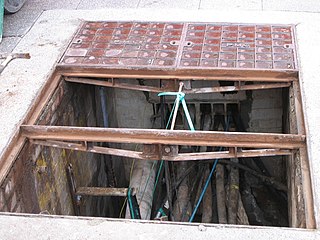
A manhole is an opening to a confined space such as a shaft, utility vault, or large vessel. Manholes are often used as an access point for an underground public utility, allowing inspection, maintenance, and system upgrades. The majority of underground services have manholes, including water, sewers, telephone, electricity, storm drains, district heating, and gas.
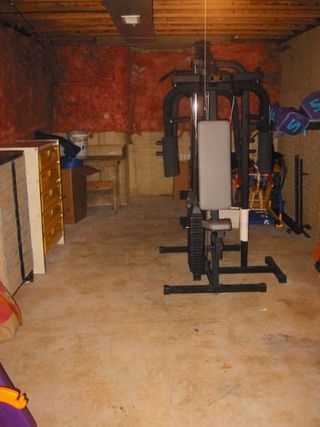
A basement or cellar is one or more floors of a building that are completely or partly below the ground floor. It generally is used as a utility space for a building, where such items as the furnace, water heater, breaker panel or fuse box, car park, and air-conditioning system are located; so also are amenities such as the electrical system and cable television distribution point. In cities with high property prices, such as London, basements are often fitted out to a high standard and used as living space.

The Chicago Tunnel Company was the builder and operator of a 2 ft narrow-gauge railway freight tunnel network under downtown Chicago, Illinois. This was regulated by the Interstate Commerce Commission as an interurban even though it operated entirely under central Chicago, did not carry passengers, and was entirely underground. It inspired the construction of the London Post Office Railway.

Consolidated Edison, Inc., commonly known as Con Edison or ConEd, is one of the largest investor-owned energy companies in the United States, with approximately $12 billion in annual revenues as of 2017, and over $62 billion in assets. The company provides a wide range of energy-related products and services to its customers through its subsidiaries:

Elevator surfing, also known as lift surfing, is an activity involving riding on top of elevators, rather than inside them. More experienced surfers may attempt riskier maneuvers such as jumping between moving elevators, or riding the elevator's counterweight. Elevator surfing is typically considered a form of urban exploration, more aligned with investigative experiences like rooftopping and tunnel hacking rather than adrenaline-inducing urban sports like train surfing. While elevator surfing was most prominent as a subculture in the United States and United Kingdom in the 1990s, it made a comeback in the late 2010s, with partakers often posting footage of their adventures on YouTube and similar platforms.

District heating is a system for distributing heat generated in a centralized location through a system of insulated pipes for residential and commercial heating requirements such as space heating and water heating. The heat is often obtained from a cogeneration plant burning fossil fuels or biomass, but heat-only boiler stations, geothermal heating, heat pumps and central solar heating are also used, as well as heat waste from factories and nuclear power electricity generation. District heating plants can provide higher efficiencies and better pollution control than localized boilers. According to some research, district heating with combined heat and power (CHPDH) is the cheapest method of cutting carbon emissions, and has one of the lowest carbon footprints of all fossil generation plants.

A utility tunnel, utility corridor, or utilidor is a passage built underground or above ground to carry utility lines such as electricity, steam, water supply pipes, and sewer pipes. Communications utilities like fiber optics, cable television, and telephone cables are also sometimes carried. One may also be referred to as a services tunnel, services trench, services vault, or cable vault. Smaller cable containment is often referred to as a cable duct or underground conduit. Direct-buried cable is a major alternative to ducts or tunnels.

A utility vault is an underground room providing access to subterranean public utility equipment, such as valves for water or natural gas pipes, or switchgear for electrical or telecommunications equipment. A vault is often accessible directly from a street, sidewalk or other outdoor space, thereby distinct from a basement of a building.
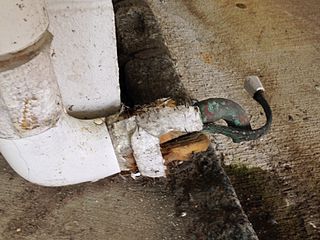
Electric heat tracing, heat tape or surface heating, is a system used to maintain or raise the temperature of pipes and vessels using heat tracing cables. Trace heating takes the form of an electrical heating element run in physical contact along the length of a pipe. The pipe is usually covered with thermal insulation to retain heat losses from the pipe. Heat generated by the element then maintains the temperature of the pipe. Trace heating may be used to protect pipes from freezing, to maintain a constant flow temperature in hot water systems, or to maintain process temperatures for piping that must transport substances that solidify at ambient temperatures. Electric trace heating cables are an alternative to steam trace heating where steam is unavailable or unwanted.

The Cecil and Ida Green Building, also called the Green Building or Building 54, is an academic and research building at the Massachusetts Institute of Technology (MIT) in Cambridge, Massachusetts. The building houses the Department of Earth, Atmospheric, and Planetary Sciences (EAPS). It is one of the tallest buildings in Cambridge.

Mine exploration is a hobby in which people visit abandoned mines, quarries, and sometimes operational mines. Enthusiasts usually engage in such activities for the purpose of exploration and documentation, sometimes through the use of surveying and photography. In this respect, mine exploration might be considered a type of amateur industrial archaeology. In many ways, however, it is closer to caving, with many participants actively interested in exploring both mines and caves. Mine exploration typically requires equipment such as helmets, head lamps, Wellington boots, and climbing gear.
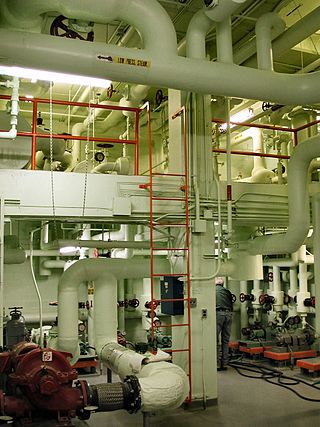
A pipefitter or steamfitter is a tradesman who installs, assembles, fabricates, maintains, and repairs mechanical piping systems. Pipefitters usually begin as helpers or apprentices. Journeyman pipefitters deal with industrial/commercial/marine piping and heating/cooling systems. Typical industrial process pipe is under high pressure, which requires metals such as carbon steel, stainless steel, and many different alloy metals fused together through precise cutting, threading, grooving, bending, and welding. A plumber concentrates on lower pressure piping systems for sewage and potable tap water in the industrial, commercial, institutional, or residential atmosphere. Utility piping typically consists of copper, PVC, CPVC, polyethylene, and galvanized pipe, which is typically glued, soldered, or threaded. Other types of piping systems include steam, ventilation, hydraulics, chemicals, fuel, and oil.

During the late 1970s and through the 1980s, Mohave and Coconino County, Arizona, immediately north and south of the Grand Canyon and west of the Navajo Indian Reservation were explored for Arizona breccia pipe uranium mineralization. The search area included the region between the Colorado River and the Utah border known as the “Arizona Strip”.

Building 20 was a temporary timber structure hastily erected during World War II on the central campus of the Massachusetts Institute of Technology. Since it was always regarded as "temporary", it never received a formal name throughout its 55-year existence.
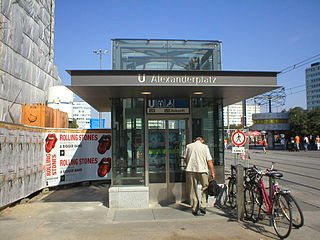
An elevator or lift is a machine that vertically transports people or freight between levels. They are typically powered by electric motors that drive traction cables and counterweight systems such as a hoist, although some pump hydraulic fluid to raise a cylindrical piston like a jack.
The college rivalry between the California Institute of Technology (Caltech) and the Massachusetts Institute of Technology (MIT) is stemming from the colleges' reputations as the top science and engineering schools in the United States. The rivalry is unusual given the geographic distance between the schools, one being in Pasadena, California, and the other in Cambridge, Massachusetts, as well as its focus on elaborate pranks rather than sporting events.

Tunnels are dug in types of materials varying from soft clay to hard rock. The method of tunnel construction depends on such factors as the ground conditions, the ground water conditions, the length and diameter of the tunnel drive, the depth of the tunnel, the logistics of supporting the tunnel excavation, the final use and shape of the tunnel and appropriate risk management. Tunnel construction is a subset of underground construction.

A sanitary manhole is a manhole that is used as an access point for maintenance and inspection of an underground sanitary sewer system. Sanitary manholes are sometimes used as vents to prevent the buildup of pressurized sewage gas. Additionally, they are used for debris removal, and application of chemicals such as degreaser and insecticide.



















